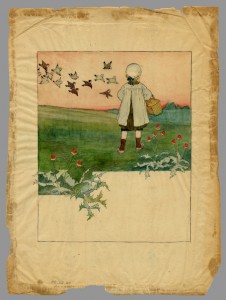

Seattle art historian David Martin’s exhibition at the Whatcom Museum is a perfect partner to the late summer days we are experiencing. We can empathize both with Colborne’s delight in the forests of the Northwest, her close up drawings, paintings, and prints, as well as her later work which suggests the devastation that those great forests invited. As in the image above, she always maintains a distance, and does not incorporate any critical comment. She only presents the fact of the lumber mill in Bellingham with amazing technical dexterity. The wood blocks with multiple subtle colors demonstrate her command of the medium. But more than that, she has suggested both the beauty and the tragedy of the Northwest forests. Another work of 1933 Cedar Blocks
as well as this one
show us the consumption of the resource in which the Northwest was so richly endowed.
Colborne’s early work is an example of late nineteenth century children’s book illustrations,  a genre full of detail, delicate color and a sweetness that has disappeared from children’s books almost entirely. I have recently been reading an early illustrated version of Raggedy Ann to my grandchildren and the illustrations are a wonder to behold, compared to later editions of the same work which are highly simplified.
a genre full of detail, delicate color and a sweetness that has disappeared from children’s books almost entirely. I have recently been reading an early illustrated version of Raggedy Ann to my grandchildren and the illustrations are a wonder to behold, compared to later editions of the same work which are highly simplified.
Colborne also did paintings that suggest her deep immersion in the woods, she seems to be standing in the very midst of the forest as she painted these works. We enjoy standing there with her.
Finally, as an end of summer image, I give you this clam digger, an image of people in an activity which I saw out of the train window on the way to the museum.
That gave me a satisfying sense of continuity with the past.
Of course it also reminded me that this was the era of those depressing images of the native peoples of the Northwest that are on many of our ferry boats, the dispossessed native peoples on the shore harvesting the bounty of the Northwest in the midst of their new poverty.